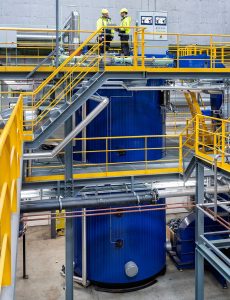Alfa Laval Aalborg Boiler and LNG Propulsion
 Alfa Laval is not an engine maker, but is nonetheless playing a key role in the move towards LNG propulsion. Alfa Laval technologies and expertise – especially in the area of boilers – are enabling marine vessels to deal with boil-off gas (BOG), which is the critical step in making the shift to LNG. Alfa Laval’s dual-fuel boilers, Gas Combustion Unit (GCU) and services form a complete portfolio of solutions for BOG safety.
Alfa Laval is not an engine maker, but is nonetheless playing a key role in the move towards LNG propulsion. Alfa Laval technologies and expertise – especially in the area of boilers – are enabling marine vessels to deal with boil-off gas (BOG), which is the critical step in making the shift to LNG. Alfa Laval’s dual-fuel boilers, Gas Combustion Unit (GCU) and services form a complete portfolio of solutions for BOG safety.
LNG is on the upswing, due to its role in reducing emissions and its relative economy compared to today’s low-sulphur fuels. “Customers are attracted to LNG propulsion for a variety of reasons, and it’s being considered for many vessel types besides LNG carriers,” says Markus Tauriainen, Manager Exhaust & Combustion System Sales at Alfa Laval.
In order to use LNG as fuel, vessels must be able to manage boil-off gas (BOG), the evaporated gas that can increase tank pressure. Alfa Laval is well known for BOG management on LNG carriers, where the Alfa Laval Gas Combustion Unit (GCU) safely burns BOG in compliance with the International code for Gas as Cargo (IGC). When it comes to using LNG for propulsion under the International code for Gas as Fuel (IGF), Alfa Laval is also managing BOG with dual-fuel Alfa Laval Aalborg boilers – and is tipping the balance in LNG’s favour for a far larger number of vessels.
When an LNG fuel tank is incorporated into a vessel, the pressure created by BOG must be kept at a level that avoids ventilation to atmosphere via the safety valve. Reliquefaction of the gas is possible, but doing this on board adds too much complexity and cost for most vessels. Likewise, burning the gas in auxiliary engines or gensets requires pressurization, which demands a redundant expensive compression train.
“On some vessels you can use a Type C tank to allow pressure to accumulate,” says Tauriainen. “But what most vessels need is a safe solution for burning off the gas at low pressure. That can be a GCU on LNG carriers, but the best and most economical solution for vessels using LNG as fuel is usually a dual-fuel boiler.”
A boiler, either for producing steam or for heating thermal oil or water, is equipment that vessels need anyway. Since an Aalborg dual-fuel boiler can be fired with LNG, it can take on the additional safety function of BOG management. “Boilers are a compact, simple and highly affordable way to handle boil-off gas,” Tauriainen says. “As strange as it may sound, our Aalborg dual-fuel boilers have been the enabler for LNG propulsion in many, many projects.”
Aalborg boilers, like the GCU, have yet another advantage when it comes to BOG management. Every fifth year, when a vessel enters dry dock for inspection, the tank environment must be made non-hazardous by replacing the LNG with inert gas. During this process, Aalborg dual-fuel boilers are capable of burning the mixture of inert gas and LNG.
“Inert gas itself doesn’t burn, so the mixture resulting from the inerting process can’t be fed to an engine or genset,” says Tauriainen. “It can be fed to an Aalborg dual-fuel boiler, however. So the boiler offers a time-saving and economical solution to this recurring issue, which otherwise has to be solved by visiting an onshore disposal terminal before and after dry docking.”






